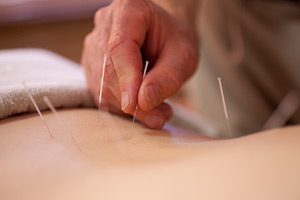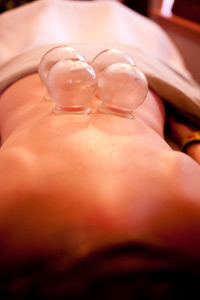“One of the advantages of acupuncture is that the incidence of adverse effects is substantially lower than that of many drugs or other accepted medical procedures used for the same conditions.”
~ National Institutes of Health, 1997
Traditional Chinese Medicine (TCM) is a complete system of medical diagnosis and treatment with a history of more than 4000 years. TCM views the body as an energetic system that functions optimally when in dynamic balance. Qi, or energy, flows to all parts of the body through a collection of connected pathways called meridians. The acupuncture points are specific locations where the meridians are accessible and where qi can be easily directed. The acupuncture meridians correspond to 12 organ systems that are collectively responsible for all functions of the body, mind and spirit. Health problems result when qi is insufficient, unbalanced or interrupted in one or more of the meridians or organ systems. The goal of TCM is to restore energetic balance to the body, mind and spirit.
Acupuncture effectively treats a wide range of symptoms, but the enduring philosophy of Oriental Medicine offers even more. Acupuncture works beyond symptomatic relief to harmonize the root imbalance from which symptoms originate. Truly holistic Chinese Medicine invites the patient to take an active role in regaining health, augmenting the subtle power of this approach. Acupuncture and Chinese Medicine focus attention on the root of the imbalance, eliminating or effectively managing symptoms when other treatments have had a waning impact or failed altogether.

The flow of Qi is influenced by every single life event, for better or worse. Some factors that disturb the flow are beyond our control, such as heredity, trauma and certain environmental conditions. The thousands of micro-decisions we make every day also affect Qi: what we eat, how we sleep, how we cope with stress, and emotional states such as anxiety, grief, anger or fear. Today’s modern, hectic lifestyle sets us up for imbalance. Symptoms are the body’s messages that something is wrong. You have only to glance at popular media to see that we live in a symptomatic society!
What you can expect from your Acupuncture Treatment

The acupuncturist has a unique repertoire of methods for figuring out how to help you. Your first visit will probably take a bit longer than follow-ups, as you will be asked to provide information about your lifestyle and general state of health. You will be asked about your current symptoms, your medical history and that of close family, your diet and digestive habits, sleeping patterns and emotional state. To get an initial picture of how energies are flowing in the body, the acupuncturist will feel your pulses on both wrists, noting their quality, rhythm and strength. Your acupuncturist will also examine your tongue; the structure, color and coating of it provide information about your physical and emotional health. The acupuncturist uses information gathered and everything she has observed during the interview and intake process to identify the underlying pattern of disharmony.
You will then be asked to lie down on a massage table and relax. Fine needles will be inserted along meridians at specific points in order to stimulate the body’s healing response and restore natural balance. Needles may be inserted briefly and removed or left in for a period of time. Acupuncture needles are unlike those used in Western medicine and will cause little or no discomfort. There may be a slight sensation when the needle initially meets the acupuncture point, often described as a dull ache, feeling of heaviness or tingling. This sensation quickly fades, bringing a feeling of comfort and relaxation. Other modalities such as cupping, Electroacupuncture, and moxibustion may also be used during your treatment.
Cupping

Cupping refers to an ancient Chinese practice in which a cup is applied to the skin and the pressure in the cup is reduced (by using change in heat or by suctioning out air), so that the skin and superficial muscle layer is drawn into and held in the cup. In some cases, the cup may be moved while the suction of skin is active, causing a regional pulling of the skin and muscle (the technique is called gliding cupping).
Generally, the cup is left in place for about 10 minutes (typical range is 5–15 minutes). The skin becomes reddened due to the congestion of blood flow. The cup is removed by pressing the skin alongside it to allow some outside air to leak into it, thus equalizing the pressure and releasing it. Some bruising along the site of the rim of the cup is expected.
Today, cupping is mainly recommended for the treatment of pain, gastro-intestinal disorders, lung diseases (especially chronic cough and asthma), and paralysis, though it can be used for other disorders as well. The areas of the body that are fleshy are preferred sites for cupping.
Moxibustion

Moxibustion is a traditional Chinese medicine technique that involves the burning of mugwort, a small, spongy herb, to
facilitate healing. Moxibustion has been used throughout Asia for thousands of years; in fact, the actual Chinese character for acupuncture, translated literally, means “acupuncture-moxibustion.” The purpose of moxibustion, as with most forms of traditional Chinese medicine, is to strengthen the blood, stimulate the flow of qi, and maintain general health
What is moxibustion used for?
In traditional Chinese medicine, moxibustion is used on people who have a cold or stagnant condition. The burning of moxa is believed to expel cold and warm the meridians, which leads to smoother flow of blood and qi. In Western medicine, moxibustion has successfully been used to turn breech babies into a normal head-down position prior to childbirth. A landmark study published in the Journal of the American Medical Association in 1998 found that up to 75% of women suffering from breech presentations before childbirth had fetuses that rotated to the normal position after receiving moxibustion at an acupuncture point on the Bladder meridian. Other studies have shown that moxibustion increases the movement of the fetus in pregnant women, and may reduce the symptoms of menstrual cramps when used in conjunction with traditional acupuncture.
Electroacupuncture
Electroacupuncture is a form of acupuncture in which pairs of acupuncture needles are attached to a device that generates continuous electric pulses between them. It is very similar to what a Physical Therapist or Chiropractor may use with a Tens Unit, only in those cases, patches are placed on the skin and the electrodes are hooked up to those.
According to some acupuncturists, this practice augments the use of regular acupuncture, can restore health and well-being, and is particularly good for treating pain.
After your initial session, the acupuncturist will engage your partnership in implementing a treatment plan regarding instructions for diet, exercise or other concerns. One thing is certain: your treatment is yours alone. It has been customized for you and for your particular concerns. Compliance with the individualized treatment plan will enhance and further your healing progress. When progress becomes apparent, your acupuncture treatments will be less frequent, yet we will always be available to you for any health and lifestyle support. Transforming your environment, your diet, your activities or your attitude even slightly can have a dramatic impact on your health!
